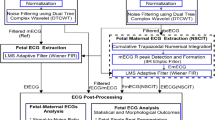Abstract
In this study, we propose a non-invasive algorithm to recognize the timings of fetal cardiac events on the basis of analysis of fetal ECG (FECG) and Doppler ultrasound signals. Multiresolution wavelet analysis enabled the frequency contents of the Doppler signals to be linked to the opening (o) and closing (c) of the heart’s valves (Aortic (A) and Mitral (M)). M-mode, B-mode and pulsed Doppler ultrasound were used to verify the timings of opening and closure of these valves. In normal fetuses, the time intervals from Q-wave of QRS complex of FECG to opening and closing of aortic valve, i.e., Q-Ao and Q-Ac were found to be 79.3 ± 17.4 and 224.7 ± 13.3 ms, respectively. For the mitral valve, Q-Mc and Q-Mo were found to be 27.7 ± 9.4 and 294.6 ± 21.3 ms, respectively. Correlations among the timings in opening and closing of cardiac valves were found to be higher in abnormal fetuses than that in normal ones.




Similar content being viewed by others
References
Ferencz C, Rubin JD, McCarter RJ (1985) Congenital heart disease: prevalence at live birth. The Baltimore-Washington infant study. Am J Epidemiol 121:31–36
Bonnet D, Coltri A, Butera G et al (1999) Detection of transposition of the great arteries in fetuses reduces neonatal morbidity and mortality. Circulation 99:916–918
Schwartz PJ (1997) The long QT syndrome. Curr Probl Cardiol 22:297–351
Vigliani M (1995) Romano-Ward syndrome diagnosed as moderate fetal bradycardia: a case report. J Reprod Med 40:725–728
Hofbeck M, Ulmer H, Beinder E, Sieber E, Singer H (1997) Prenatal findings in patients with prolonged QT interval in the neonatal period. Heart 77:198–204
Matonia A, Jezewski J, Kupka T, Wrobel J, Horoba K, Widera M (2005) Instrumentation for fetal cardiac performance analysis during the antepartum period. In: Proceedings of the IEEE engineering in medicine and biology 27th annual conference, NY, pp 1–4
Murata Y, Martin CB (1974) Systolic time intervals of the fetal cardiac cycle. Obstet Gynecol 44:224–232
Goodlin RC, Girard J, Hollmen A (1968) Systolic time intervals in the fetus and neonate. Circulation 37:149–159
Sato M, Kimura Y, Chida S, Ito T, Katayama N, Okamura K, Nakao M (2007) A novel extraction method of fetal electrocardiogram from the composite abdominal signal. IEEE Trans Biomed Eng 54(1):49–58
Shakespeare SA, Crowe JA, Hayes-Gill BR, Bhogal K, James DK (2001) The information content of Doppler ultrasound signals from the fetal heart. Med Biol Eng Comput 39:619–626
Tsyvian P, Malkin K, Wladimiroff JW (1995) Assessment of fetal left cardiac isovolumic relaxation time in appropriate and small-for-gestational-age-fetuses. Ultrasound Med Biol 21:739–743
Hawrylyshyn PA, Benstein A, Organ LW (1982) Fetal preejection period. Obstet Gynecol 59:747–754
Koga T, Athayde B, Trundinger B, Nakano H (2001) A new and simple Doppler method for measurement of fetal cardiac isovolumetric contraction time. Ultrasound Obstet Gynecol 18:264–267
Kupka T, Jezewski J, Matonia A, Horoba K, Wrobel J (2004) Timing events in Doppler ultrasound of fetal heart activity. In: Proceedings of the 26th annual international conference of the IEEE EMBS San Francisco, CA, USA September 1–5, 2004
Ferrario M, Signorini MG, Magenes G (2009) Complexity analysis of the fetal heart rate variability: early identification of severe intrauterine growth-restricted fetuses. Med Biol Eng Comput. doi:10.1007/s11517-009-0502-8
Gonçalves H, Rocha AP, Ayres-de-Campos D, Bernardes J (2006) Linear and nonlinear fetal heart rate analysis of normal and acidemic fetuses in the minutes preceding delivery. Med Biol Eng Comput 44(10):847–855
Acknowledgements
This study was supported by an Early career researcher (ECR) grant awarded to AH Khandoker by University of Melbourne with partial support received from Australian Research Council (ARC) research networks on Intelligent sensing, sensor networks and information processing (ISSNIP). The authors would like to thank Dr Slaven Marusic and Dr Mak Daulatzai of University of Melbourne for revising and editing the manuscript.
Author information
Authors and Affiliations
Corresponding author
Rights and permissions
About this article
Cite this article
Khandoker, A.H., Kimura, Y., Ito, T. et al. Antepartum non-invasive evaluation of opening and closing timings of the cardiac valves in fetal cardiac cycle. Med Biol Eng Comput 47, 1075–1082 (2009). https://doi.org/10.1007/s11517-009-0528-y
Received:
Accepted:
Published:
Issue Date:
DOI: https://doi.org/10.1007/s11517-009-0528-y




